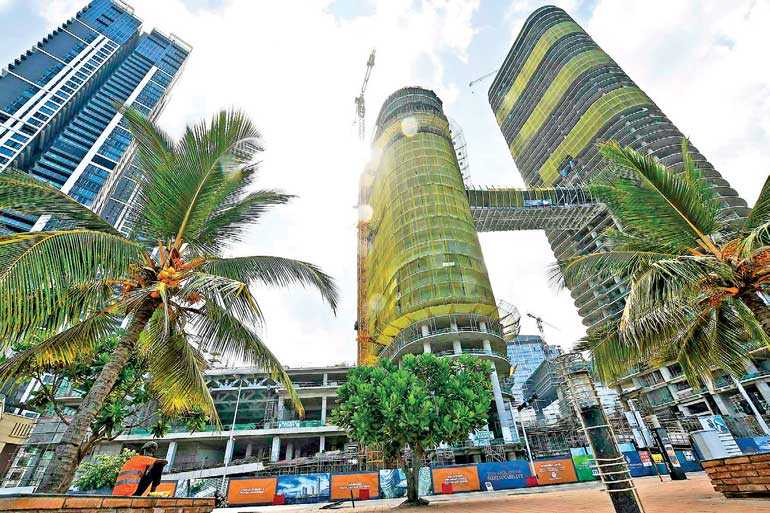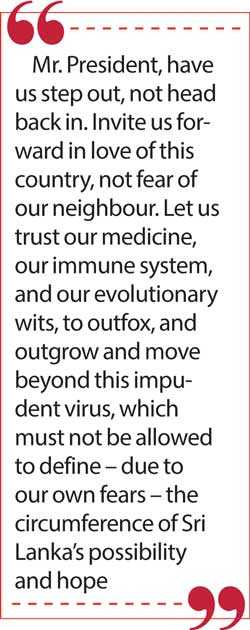Friday Jan 09, 2026
Friday Jan 09, 2026
Tuesday, 2 June 2020 00:30 - - {{hitsCtrl.values.hits}}

Evidence-free assertions of “high risk” Colombo, which seems not to have seen a case in community terms in over a month, keeps half of the GDP locked up, even as some parts of the country get relief – Pic by Shehan Gunasekara
Let me first suggest, that despite an encouraging few weeks, we haven’t fully “moved on”. We have yet to have one week since 20 March, or a simple seven-day period, where there hasn’t been at least one day, if not more, of “islandwide curfews”.
This seems particularly strange given that we are told there have not been any new community cases for over three weeks. If so, it’s hard to understand why a Poya celebration is a reason for two days of curfew? Perhaps it needs to be managed for prudence, and perhaps regions where worshippers flock and tend to congregate, need to be controlled to some degree. But the entire island?
And the Sunday curfews? Is there a particular aspect to Sunday that makes COVID especially lethal?
The Chief Justice of the Pakistani Supreme Court about 10 days back declared weekend “lockdowns” (curfew’s milder cousin) “unconstitutional” and so struck them down. He asked how “the name of a day” made it more dangerous. Perfectly fair question.
He also asked why resources and attention were still being so unduly siphoned to this one illness. He pointed out it is not a “pandemic” in Pakistan. And if so, by the way, it certainly isn’t in Sri Lanka! After all, dengue fatalities in Lanka for this year are already double the published COVID death rate.
The Pakistani Supreme Court Chief Justice warned that other things require attention and investment and pointed out historically in Pakistan (arguably also applicable here), businesses have left and re-established elsewhere if they encountered too many obstacles to being able to operate and function, which then has had further highly-negative ripple effects on business investment, ensuing unemployment and more.
I have already, as an example, been privy to hearing revised thinking from a major European financial firm, wondering if our business landscape here in Lanka will be predictable and consistent enough, much less competitive enough, for them to continue with their plans. I have tried to suggest that they take a longer view than COVID exigencies, but each week that gets harder to credibly assert.
Minister Bandula Gunewardene flagged what he pegged as the greatest upcoming forex crisis in Lankan history. However, simple import controls won’t resolve it of course, as Sri Lanka offers global services, has a huge need of tourists and all they demand when here. So, a suite of interventions are needed as he highlights, and of course we are seeking unconditional debt relief or deferral from global donors and partners. None of that seems credible, or can gather much momentum, if we keep reflexively almost applying tactics like unexplained, recurring curfews.
Businesses cannot get momentum, smaller businesses won’t reopen to undertake staffing costs, tourists won’t come if they know they can be locked up or locked down, hard hit sectors, including tourism, can’t woo COVID-shy local demand even if there isn’t a normal week in sight. And this must be assured as part of a recovery strategy. It cannot just be done in secret councils, and “announced” unless we literally want to “shock” people into emotional and psychological paralysis as they continue to await “breaking news.” But then these are the same people we want to call on, to step out, and assertively stimulate and revive the economy!
Some more COVID facts
Virtually none of the world completely stopped their economy, and none for as long as we did here. Those that had relatively draconian exercises in “containment” had thousands and tens of thousands of cases and many thousands of deaths. So, perhaps their situation was rather different than what has been experienced in Asia, particularly South Asia, and especially Sri Lanka. Our benchmark should be more Vietnam than Italy.
In Europe, recriminations are already underway against the penal “lockdown” mania. The Danish National Board of Health has said they never advised a lockdown and don’t support it now, “second wave” or not. They claim the Danish Prime Minister used the phrase “authorities” in claiming she was so advised, intemperately and inaccurately.
The Danish Director of the National Board of Health signed a recommendation in late February which explicitly stated that general encroachment on Danes’ freedom were to be excluded. Since opening schools and increasingly more of society weeks back, Denmark has seen nothing but declines in infection rates. Despite one of the lowest mortality rates in Europe, digging through the real data now, and the impact of shutting down so drastically, they are arriving at a very different consensus.
Belgium, at the other end of the spectrum, has had many more deaths than “lockdown” liberal Sweden, and so you would expect them to be traumatised. But Interior Minister Pieter de Crem said last Sunday that Belgium’s hospitals were never in danger of being overrun. He says, “If there were a second wave, then I think we will find ourselves in a different situation, namely with testing and tracing.” And certainly, without the disastrous handling of nursing homes we take it. He concludes, “But I think we can rule out that we will have to go back to tough measures.”
Norway has also had one of the lowest mortality rates. Though over-ruled earlier, the head of the Norwegian Institute of Public Health now states that Norway could have brought the pandemic under control without a lockdown. The Agency’s Director General, Camile Stoltenberg says, “Our assessment now…is that we could possibly have achieved the same effects and avoided some of the unfortunate impacts by not locking down, but instead keeping open but with infection control measures.” She says they now know the reproduction number had already fallen to as low as 1.1 even before lockdown was announced on 12 March.
The peak having been passed pre-lockdown or otherwise too early into “lockdown” for that to have been the elixir or tonic, is being found globally, in country after country. Stoltenberg says, unless truly overwhelmed, any such measures should be avoided going forward, “second wave” or not.
Japan is now out of their extremely mild, legal “emergency” that left virtually all of the society open anyway, with some of the lowest mortality numbers of any industrialised economy. They did no contact tracing, they wear masks and avoid congested spaces, that’s it essentially. In a nutshell: avoid mass gatherings and super-spreaders is Japan’s winning prescription.
We see Pareto infectiousness as we study this. In Hong Kong, 20% were responsible for roughly 80% of the spread. In Israel (another opened up low-COVID count country that says such intrusions into people’s freedom are not merited and the disease peaks regardless of lockdown, based on data) estimates that 1-10% were responsible for 80%. All other measures, they say, amount to “disproportionate collateral damage”.
Switzerland has also exited their “national emergency” strictures, and numbers continue to plummet. No resurgence of hospitalisations or new cases was seen, and so they advanced their next phase of opening up by one month a few weeks back.
And indeed, as cited, US States like Georgia, Florida, Texas are just not seeing any resurgence of infections, much less hospitalisations.
Half the uninfected already immune?
It’s a strange virus. We now know it’s been around since December 2019, killed very few people then. Infected many, but many are asymptomatic and move past it, so the fatality rate is a fraction of “official” numbers.
It kills vulnerable people for several weeks, then peaks after six weeks or so, and starts to disappear. The same essential curve has been found in every country; the virus seems to hit a brick wall and then tapers off. If antibody tests are showing 10-15% overall, indeed up to 25% in the NYC area, then yes down goes the fatality rate, but that would not suggest anywhere close to the “herd immunity” being sought, in terms of explaining the radical downward trajectory we see.
A credible research paper doing the rounds suggests there may be cross-immunity from other coronaviruses, and this could partially explain the Asian immunological charm here. Perhaps general lack of hygiene toughens responses too, hence the virus infiltrates prisons for example, but most are asymptomatic, and very few to date seem to die.
Professor Karol Sikora, founder of the University of Buckingham Medical Schools, says: “We have more cellular immunity (T cells) than estimated. Lots of recovered people simply don’t have antibodies, but also many have residual immunity from old viruses (colds, etc.). This is significant.”
This has been echoed by Professor Sunetra Gupta, Professor of Theoretical Epidemiology at Oxford University, as well as by Stanford’s Professor John Ioannidis.
Essentially, irrespective of the “lockdown” policy, the epidemic swells, then retreats, and continues to diminish and die away.
The above are currently tested and well-informed suppositions, not yet fully confirmed in terms of explaining why, but they are suppositions that actually are consistent with the facts, unlike the fanciful plague prescription of madcap lock up and economic devastation portraying itself as a medical strategy.
Inhibiting our will to recover and to fight
So, we can arguably establish this is not a viral Chernobyl, but it certainly is mass media hysteria on steroids coupled with madcap extrapolation.
So, who will revitalise the economy?
Let’s go back to 20 March or 24 March here in Lanka, and you have been indefinitely “curfewed”. No justification for this extreme outer extremity of penal “lockdown” is given, other than my hearing it being asserted that Sri Lankans are ill disciplined, and we must be thrilled by the ability of the Chinese to suspend liberties at whim.
A few weeks pass, no spike in cases, but no fall off either…you can’t flatten a non-existent curve, and you can’t “intimidate” viruses into submission. The fatality needle doesn’t budge. It was and remains virtually non-existent.
You’re still locked away, your debts are rising, your business is collapsing, you have to not pay people, or lay them off, or try and get loans; you have no life; you are stifling inside, and you have to manage the anxieties of your entire family too.
No endgame is shared, no rational milestone that will trigger an alleviation to the suspension of your life as you know it. If you trade regionally or globally, you watch in horror as all your markets seemingly disappear. If you have a daily wage to earn, you learn to scavenge, or beg, or do who knows what.
A lifetime of business planning collapses, your once-proud enterprise has no clients, and no one will indicate how “low” cases have to drop in this country to have some shot at resuming economic life.
No rationale is shared, even though Asia starts racking up success stories, and fatality statistics keep falling worldwide. But you are helpless, hopeless, voiceless, with no basis to object.
Dates for curfew relief are shared and widely repeated, and you are briefly buoyed. And then a super-spreader family returning from India tampers with the optics, and the plug is pulled on relaxing strictures, even though it is a contained, identified cluster. Then, approaching a new reprieve, we have a never-ending Navy cluster that emerges, and dates keep shifting again, just as we were again on the brink of “some” hopefulness. Each calendar date that passes, delivers another blow to the residual optimism everyone has desperately been holding on to.
Evidence-free assertions of “high risk” Colombo, which seems not to have seen a case in community terms in over a month, keeps half of the GDP locked up, even as some parts of the country get relief.
There are costs to re-opening, and business owners and managers are wary of undertaking these, with dates and gates shifting, and weekly curfews galore, never with any explanation. This seems perplexing as we are also being told it’s safe to have elections and again, we hear a reconfirmation that there have been no community cases for over three weeks.
So, you do not quite know what to believe. What if you believe these indicators, and outlay more money, hire people back or go back to paying salaries, and 20 cases later, despite the global trend of re-opening and 20 cases being counted as “nominal” everywhere else, you are shut down again, with a seeming almost detached impunity?
You watch as money is printed in a frenzy, credit ratings are downgraded, and in desperate fear of this one virus, not anywhere close in terms of lethality to heart attacks or hypertension deaths in this country, we paralyse and decimate our economy and more, the fabric of everyday social existence.
Now, finally you are told, “All clear!” “Go and rebuild our economy. Invest! Grow your business, take intelligent risks for economic growth.”
And yet by now you are scared out of your wits, you no longer trust your instincts, you don’t fully trust what you’re told. You can’t be “ordered” into being an engine of enterprise all of a sudden. The internal pilot light has been deeply dimmed.
You take some tentative steps, but are frightened of any loud noise, which might again shout, “lockdown, curfew!” The message you’ve internalised is, listen to your masters, suspend your life. Though for your own good (and doubtless that has been the intention), the message is you don’t even own the right to take intelligent risks with your life, we can “possess” your private property by telling you to keep it closed, we can bankrupt your economy, and you have no say, no voice, no choice. Oh, but Tuesday, we’ll open again…go! Rebuild the economy!
You cannot, psychologically and emotionally, paralyse and numb people, and take away any personal discretion and latitude for extended periods of time, keep them detached from any meaningful dialogue or rationale for things that make and break their lives, and expect them to suddenly move forward economically vital and full of patriotic fervour to “rescue” the economy, while a part of them has been shrivelling minute by minute, hour by hour, for months.
The greatest risk is to not to risk
We walk past a bridge in San Francisco, and see a youngster leaping over a hurdle. The little surge of freedom, that ephemeral moment of expression, might in the future underwrite an impulse to create something, to start something, to lead something.
Every act in life worth taking is fool-hardy to some extent…choosing a career, starting a business, opting to be a parent, moving geographies, switching careers, committing to philanthropy when not fully financially self-sufficient.
Imagine if human history were a cowering collection of acts seeking some illusory “guarantee” of safety. Lionel Shriver points out Shackleton wouldn’t have gotten near the South Pole if afraid of it being a tad “frosty,” Livingstone upon finding Victoria Falls would have rushed to wash his hands in it; how could Churchill so late in life sign up to stand so unbowed with his besieged and terrified nation; why would those climbing Everest not opt for a few sprints up the home staircase with hand sanitiser instead? Why would anyone run a marathon, or pick themselves up from the ashes of failure?
We put chalk circles around youngsters who we know virtually definitively are not at risk from COVID, but so clearly are at psychological and emotional risk. Will we go from childhood helplessness to aged brittle hyper-caution with no adult expansiveness or deeds of daring in between?
And so here, this nation of artistic, musical, caring, giving, emphatic, empathic, warm, intuitive people, must be roused again. We must tell each other the truth. We have all of us succumbed to the greatest, most pathetic, inadvertent global hoax in history. But, with our leaders and together as a community, we can find creative and resilient ways past this and move on.
It was well-intentioned concern for public safety, but then there was no agreed off-ramp. And we thought we could “control” what we have to “manage” and learn to immunologically cope with and finally learn to move beyond.
In a nutshell
If we want people to be leaders, we have to give them the conditions in which leaders flourish. Those conditions crucially include latitude and discretion and prudent enterprising freedom, not being ordered indoors at every development, while hope and energy continue to flicker and sputter and diminish.
Mr. President, have us step out, not head back in. Invite us forward in love of this country, not fear of our neighbour. Let us trust our medicine, our immune system, and our evolutionary wits, to outfox, and outgrow and move beyond this impudent virus, which must not be allowed to define – due to our own fears – the circumference of Sri Lanka’s possibility and hope.